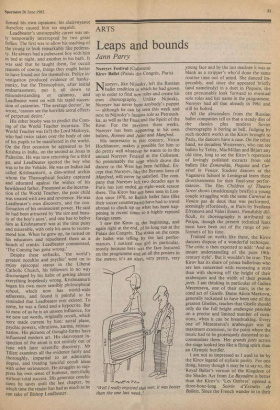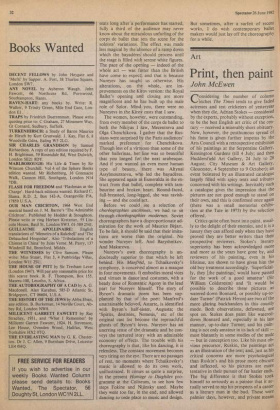ARTS
Leaps and bounds
Jann Parry
Nureyev Festival (Coliseum) Kirov Ballet (Palais des Congres, Paris)
Nureyev, like Nijinsky, left the Russian ballet tradition in which he had grown up in order to find new roles and create his own choreography. Unlike Nijinsky, Nureyev has never been anybody's puppet — although he can be seen this week and next in Nijinsky's famous role as Petroush- ka, as well as the Faun and the Spirit of the Rose. For the previous three weeks, Nureyev has been appearing in his own ballets, Romeo and Juliet and Manfred.
His impresario in this country, Victor Hochhauser, makes it possible for him to do pretty well whatever he wants to in the annual Nureyev Festival at the Coliseum. So presumably the urge which drove the dancer to the West has been fulfilled. Ex- cept that Nureyev, like the Byronic hero of Manfred, will never be satisfied. The com- pany that Nureyev left two decades ago in Paris has just ended an eight-week season there. The Kirov has not been seen in Lon- don since 1970, so British ballet fans (like their soccer counterparts) have had to travel abroad to check up on what has been hap- pening in recent times to a highly reputed foreign team.
I saw the Kirov at the beginning, and again right at the end, of its long run at the Palais des Congres. The strain on the corps de ballet was telling by the last perfor- mances. I noticed one girl in particular, mostly because hers was the face featured on the programme and on all the posters in the metro; it's an alert, very pretty, very
'Well I really enjoyed that war, it was better than the one last week.' young face and by the last matinee it was as blank as a stripper's who'd done the same routine time out of mind. She danced im- peccably, and since she appeared briefly (and namelessly) in a duet in Paquita, she can presumably look forward to eventual solo roles and her name in the programme. Nureyev had all that already in 1961 and still he bolted.
All the absconders from the Russian ballet companies tell us that a steady diet of the classics plus modern Soviet choreography is boring as hell. Judging by such modern works as the Kirov brought to Paris, the dancers have a case. On the other hand, we decadent Westerners, who can see ballets by Tetley, MacMillan and Bejart any old time, long to see the Kirov's repertoire of lovingly polished extracts from old ballets like Esmeralda, Paquita and Car- nival in Venice. Student dancers at the Vaganova School in Leningrad learn these divertissements for their final-year perfor- mances. The film Children of Theatre Street shows (maddeningly briefly) a young couple struggling with the same Carnival in Venice pas de deux that was performed, seemingly effortlessly, in Paris by Svetlana Efremova and Valeri Emets. Fiendishly dif- ficult, its choreography is attributed to Petipa, though the present technical feats must have been out of the range of per- formers of his time.
Trained on works like these, the Kirov dancers dispose of a wonderful technique. The critic is then expected to add: 'And an innate understanding of the pure 19th- century style'. But it wouldn't be true. The Kirov has its share of prima ballerinas who are less concerned with recreating a style than with showing off the height of their arabesques and the width of their grands fetes. I am thinking in particular of Galina Mezentseva, one of their stars, in the se- cond act of Giselle. Dame Alicia Markova, generally reckoned to have been one of the greatest Giselles, teaches that Giselle should only do the full height arabesque pencil& on a precise and limited number of occa- sions, when it can be breathtaking. Every one of Mezentseva's arabesques was at maximum extension, to the point where the music had to be grotesquely distorted to ac- commodate them. Her grands fetes across the stage looked less like a flying spirit than an Olympic hurdler.
I am not as impressed as I used to be by the Kirov legend of stylistic purity. For one thing, heresy though it may be to say so, the Royal Ballet's version of the Kingdom of the Shades Act from La Bayadere is better than the Kirov's. 'Les Ombres' opened a three-hour-long Soiree d'Extraits de Ballets. Since the French wander in to their
seats long after a performance has started, fully a third of the audience may never know about the miraculous unfurling of the corps de ballet that sets the scene for the soloists' variations. The effect was made less magical by the absence of a ramp down which the bayaderes should process until the stage is filled with serene white figures. The pace of the opening — indeed of the whole act — was faster than the British have come to expect; and that is because Nureyev has taught us otherwise. His alterations, on the whole, are im- provements on the Kirov version: the Royal Ballet's opening and closing are more magnificent and he has built up the male role of Solon Mind you, there were no Nureyevs in the Kirov casts that I saw.
The women, however, were outstanding, from every member of the corps de ballet to both the Nikiyas I saw, Mezentseva and Olga Chenchikova. I gather that the Rus- sians were surprised by the Paris audiences' marked preference for Chenchikova. Though less of a virtuoso than some of the other ballerinas, her line was so beautiful that you longed for the next arabesque. And if you wanted an even more human type of beauty, there was Altynai Assylmouratova, who led the bayaderes. She appeared again as Esmeralda in the ex- tract from that ballet, complete with tam- bourine and broken heart. Round-faced, full-breasted, long-legged, she was ravish- ing — and she could act.
Before we could see a selection of choreographies anciennes, we had to sit through choreographies modernes. Soviet choreographers have a disproportionate ad- miration for the work of Maurice Bejart. To be fair, it should be said that their imita- tions are worse than the original. No wonder Nureyev left. And Baryshnikov. And Makarova.
Nureyev's own choreography is un- doubtedly superior, to that which he left behind. His Manfred, to Tchaikovsky's symphony, is conceived almost as a masque in four movements. It embodies moral vices and virtues in dance and costumes, with a heady dose of Romantic Agony in the lead part for Nureyev himself. The story of Byron's dramatic poem has been sup- planted by that of the poet: Manfred's unattainable beloved, Astarte, is identified with Byron's half-sister, Augusta; the 'Spirits, destinies, Nemesis,' etc of the original cast list become the reproachful ghosts of Byron's loves. Nureyev has an unerring sense of the dramatic and he con- veys the tortured story with an admirable economy of effects. The trouble with his choreography is that, like his dancing, it is relentless. The constant movement becomes very tiring on the eye. There are no passages of rest, no moments where Tchaikovsky's music is allowed to do its own work, unillustrated. It comes as quite a surprise, in the present Homage to Diaghilev pro- gramme at the Coliseum, to see how few steps Fokine and Nijinsky used. Maybe they went too far, in the end, and allowed dancing to cede place to music and design.
But sometimes, after a surfeit of recent works, I do wish contemporary ballet makers would just lay off the choreography for a while.























































 Previous page
Previous page